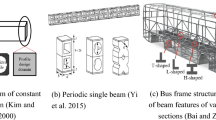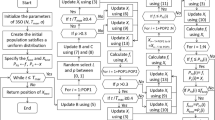Abstract
In this paper, flaw detection of two-dimensional structures is carried out using the extended spectral finite element method (XSFEM) associated with particle swarm optimization (PSO) algorithm enhanced by a new so-called active/inactive flaw (AIF) strategy. The AIF strategy, which is inspired from earthquake engineering concepts, is proposed for the first time in this paper. The XSFEM is employed to model the cracked and holed structures, while the PSO, which is a suitable non-gradient method for solving such problems, is employed to find crack location as an optimizer. The XSFEM consists of remarkable capabilities with the main features of spectral finite element method (SFEM) and extended finite element method (XFEM) to analyze the damaged structures without remeshing, leading it to be a proper approach in iterative processes. Moreover, the XSFEM enhances the accuracy of wave propagation analysis, and decreases computational cost as well in comparison with the XFEM. The application of XSFEM in damage detection of structures is studied for the first time in this paper. Furthermore, the AIF strategy is proposed in order to handle a simultaneously discrete and continuous optimization in an efficient way reducing computational effort. Considering the AIF as a universal strategy, it can be used in any meta-heuristic optimizer. In this research, the PSO is seeking for geometrical properties and the number of flaws in order to detect them by minimizing an error function based on sensor measurements. To overcome the challenge of unknown number of flaws, the proposed AIF strategy is employed in the PSO. Several benchmark examples are examined to evaluate capability and accuracy of the proposed algorithm for detection of cracks and holes.

















Similar content being viewed by others
References
Ahmadi HR, Daneshjoo F, Khaji N (2015) New damage indices and algorithm based on square time–frequency distribution for damage detection in concrete piers of railroad bridges. Struct Control Health Monit 22:91–106. doi:10.1002/stc.1662
Barroso ES, Parente E, Cartaxo de Melo AM (2016) A hybrid PSO-GA algorithm for optimization of laminated composites. Struct Multidiscip Optim 55(6):2111–2130. doi:10.1007/s00158-016-1631-y
Begambre O, Laier JE (2009) A hybrid particle swarm optimization–simplex algorithm (PSOS) for structural damage identification. Adv Eng Softw 40:883–891
Belytschko T, Liu WK, Moran B (2000) Finite elements for nonlinear continua and structures J Wiley
Benaissa B, Aït Hocine N, Belaidi I, Hamrani A, Pettarin V (2016) Crack identification using model reduction based on proper orthogonal decomposition coupled with radial basis functions. Struct Multidiscip Optim 54:265–274. doi:10.1007/s00158-016-1400-y
Chang W-D (2015) A modified particle swarm optimization with multiple subpopulations for multimodal function optimization problems. Appl Soft Comput 33:170–182
Chatzi EN, Hiriyur B, Waisman H, Smyth AW (2011) Experimental application and enhancement of the XFEM–GA algorithm for the detection of flaws in structures. Comput Struct 89:556–570
Doebling SW, Farrar CR, Prime MB (1998) A summary review of vibration-based damage identification methods. Shock and vibration digest 30:91–105
Dolbow J, Belytschko T (1999) A finite element method for crack growth without remeshing. Int J Numer Methods Eng 46:131–150
Edke MS, Chang K-H (2011) Shape optimization for 2-D mixed-mode fracture using extended FEM (XFEM) and level set method (LSM). Struct Multidiscip Optim 44:165–181. doi:10.1007/s00158-010-0616-5
Fatemi M, Greenleaf JF (1999) Vibro-acoustography: an imaging modality based on ultrasound-stimulated acoustic emission. Proc Natl Acad Sci 96:6603–6608
Fleming M, Chu Y, Moran B, Belytschko T, Lu Y, Gu L (1997) Enriched element-free Galerkin methods for crack tip fields. Int J Numer Methods Eng 40:1483–1504
Giurgiutiu V, Zagrai A (2005) Damage detection in thin plates and aerospace structures with the electro-mechanical impedance method. Struct Health Monit 4:99–118
Hellier C (2001) Handbook of nondestructive evaluation
Jia H, Takenaka T, Tanaka T (2002) Time-domain inverse scattering method for cross-borehole radar imaging. IEEE Trans Geosci Remote Sens 40:1640–1647
Jung J, Taciroglu E (2014) Modeling and identification of an arbitrarily shaped scatterer using dynamic XFEM with cubic splines. Comput Methods Appl Mech Eng 278:101–118
Jung J, Jeong C, Taciroglu E (2013) Identification of a scatterer embedded in elastic heterogeneous media using dynamic XFEM. Comput Methods Appl Mech Eng 259:50–63
Kaveh A (2014) Advances in metaheuristic algorithms for optimal design of structures. Springer,
Kaveh A, Zakian P (2013) Optimal design of steel frames under seismic loading using two meta-heuristic algorithms. J Constr Steel Res 82:111–130
Kaveh A, Zakian P (2014) Optimal seismic design of reinforced concrete shear wall-frame structures KSCE. J Civ Eng 18:2181–2190
Kaveh A, Aghakouchak A, Zakian P (2015) Reduced record method for efficient time history dynamic analysis and optimal design. Earthquakes and Structures 8:639–663
Khaji N, Kazemi Noureini H (2012) Detection of a through-thickness crack based on elastic wave scattering in plates part I forward solution. Asian Journal of Civil Engineering (BHRC) 13:301–318
Kudela P, Żak A, Krawczuk M, Ostachowicz W (2007) Modelling of wave propagation in composite plates using the time domain spectral element method. J Sound Vib 302:728–745
Lakshmi K, Mohan Rao AR (2013) Optimal design of laminate composite isogrid with dynamically reconfigurable quantum PSO. Struct Multidiscip Optim 48:1001–1021. doi:10.1007/s00158-013-0943-4
Legay A, Wang H, Belytschko T (2005) Strong and weak arbitrary discontinuities in spectral finite elements. Int J Numer Methods Eng 64:991–1008
Lei W, Xiaojun W, Xiao L (2016) Inverse system method for dynamic loads identification via noisy measured dynamic responses. Eng Comput 33:1070–1094. doi:10.1108/EC-04-2015-0103
Liu Z, Menouillard T, Belytschko T (2011) An XFEM/spectral element method for dynamic crack propagation. Int J Fract 169:183–198
Luh G-C, Lin C-Y (2011) Optimal design of truss-structures using particle swarm optimization. Comput Struct 89:2221–2232
Mehrjoo M, Khaji N, Moharrami H, Bahreininejad A (2008) Damage detection of truss bridge joints using artificial neural networks. Expert Syst Appl 35:1122–1131. doi:10.1016/j.eswa.2007.08.008
Mehrjoo M, Khaji N, Ghafory-Ashtiany M (2013) Application of genetic algorithm in crack detection of beam-like structures using a new cracked Euler–Bernoulli beam element. Appl Soft Comput 13:867–880. doi:10.1016/j.asoc.2012.09.014
Menouillard T, Song J-H, Duan Q, Belytschko T (2010) Time dependent crack tip enrichment for dynamic crack propagation. Int J Fract 162:33–49
Mian A, Han X, Islam S, Newaz G (2004) Fatigue damage detection in graphite/epoxy composites using sonic infrared imaging technique. Compos Sci Technol 64:657–666
Michaels JE (2008) Detection, localization and characterization of damage in plates with an in situ array of spatially distributed ultrasonic sensors. Smart Mater Struct 17:035035
Nanthakumar S, Lahmer T, Rabczuk T (2013) Detection of flaws in piezoelectric structures using extended FEM international. Journal for Numerical Methods in Engineering 96:373–389
Nanthakumar S, Lahmer T, Rabczuk T (2014) Detection of multiple flaws in piezoelectric structures using XFEM and level sets. Comput Methods Appl Mech Eng 275:98–112
Noël L, Duysinx P (2016) Shape optimization of microstructural designs subject to local stress constraints within an XFEM-level set framework. Struct Multidiscip Optim 55(6):2323–2338. doi:10.1007/s00158-016-1642-8
Papila M, Haftka RT (2003) Implementation of a crack propagation constraint within a structural optimization software. Struct Multidiscip Optim 25:327–338. doi:10.1007/s00158-003-0329-0
Patera AT (1984) A spectral element method for fluid dynamics: laminar flow in a channel expansion. J Comput Phys 54:468–488. doi:10.1016/0021-9991(84)90128-1
Peng H, Meng G, Li F (2009) Modeling of wave propagation in plate structures using three-dimensional spectral element method for damage detection. J Sound Vib 320:942–954
Rabinovich D, Givoli D, Vigdergauz S (2007) XFEM-based crack detection scheme using a genetic algorithm. Int J Numer Methods Eng 71:1051–1080. doi:10.1002/nme.1975
Rabinovich D, Givoli D, Vigdergauz S (2009) Crack identification by ‘arrival time’ using XFEM and a genetic algorithm international. Journal for Numerical Methods in Engineering 77:337–359. doi:10.1002/nme.2416
Shi Y, Eberhart R (1998) A modified particle swarm optimizer. In: Proceedings of the IEEE Conference on Evolutionary Computation, ICEC. IEEE World Congress on Computational Intelligence. pp 69–73
Shi Q, Wang X, Wang L, Li Y, Chen X (2017) Set-membership identification technique for structural damage based on the dynamic responses with noises. Struct Control Health Monit 24:e1868. doi:10.1002/stc.1868
Sohn H, Farrar CR, Hemez FM, Shunk DD, Stinemates DW, Nadler BR, Czarnecki JJ (2003) A review of structural health monitoring literature: 1996–2001 Los Alamos National Laboratory, USA
Sridhar R, Chakraborty A, Gopalakrishnan S (2006) Wave propagation analysis in anisotropic and inhomogeneous uncracked and cracked structures using pseudospectral finite element method international. Journal of Solids and Structures 43:4997–5031
Sukumar N, Chopp DL, Moës N, Belytschko T (2001) Modeling holes and inclusions by level sets in the extended finite-element method. Comput Methods Appl Mech Eng 190:6183–6200
Sun H, Waisman H, Betti R (2013) Nondestructive identification of multiple flaws using XFEM and a topologically adapting artificial bee colony algorithm. Int J Numer Methods Eng 95:871–900
Sun H, Waisman H, Betti R (2014a) A multiscale flaw detection algorithm based on XFEM. Int J Numer Methods Eng 100:477–503
Sun H, Waisman H, Betti R (2014b) A two-scale algorithm for detection of multiple flaws in structures modeled with XFEM. In: SPIE Smart Structures and Materials+ Nondestructive Evaluation and Health Monitoring. International Society for Optics and Photonics, pp 906322–906322-906314
Sun H, Waisman H, Betti R (2016) A sweeping window method for detection of flaws using an explicit dynamic XFEM and absorbing boundary layers international. Journal for Numerical Methods in Engineering 105:1014–1040
Urban M, Alizad A, Aquino W, Greenleaf J, Fatemi M (2011) A review of vibro-acoustography and its applications in medicine. Current Medical Imaging Reviews 7:350–359
Waisman H, Chatzi E, Smyth AW (2010) Detection and quantification of flaws in structures by the extended finite element method and genetic algorithms. Int J Numer Methods Eng 82:303–328
Wang L, Wang X, Li Y, Lin G, Qiu Z (2016) Structural time-dependent reliability assessment of the vibration active control system with unknown-but-bounded uncertainties. Struct Control Health Monit. doi:10.1002/stc.1965
Yan G, Sun H, Waisman H (2015) A guided Bayesian inference approach for detection of multiple flaws in structures using the extended finite element method. Comput Struct 152:27–44
Yuan H, Guzina BB (2012) Topological sensitivity for vibro-acoustography applications. Wave Motion 49:765–781
Zakian P, Khaji N (2016a) A novel stochastic-spectral finite element method for analysis of elastodynamic problems in the time domain. Meccanica 51:893–920. doi:10.1007/s11012-015-0242-9
Zakian P, Khaji N (2016b) Spectral finite element simulation of seismic wave propagation and fault dislocation in elastic media. Asian Journal of Civil Engineering (BHRC) 17:1189–1213
Acknowledgements
The authors wish to acknowledge and express their special gratitude to anonymous reviewers, for their constructive advices that improved the manuscript.
Author information
Authors and Affiliations
Corresponding author
Rights and permissions
About this article
Cite this article
Livani, M.A., Khaji, N. & Zakian, P. Identification of multiple flaws in 2D structures using dynamic extended spectral finite element method with a universally enhanced meta-heuristic optimizer. Struct Multidisc Optim 57, 605–623 (2018). https://doi.org/10.1007/s00158-017-1767-4
Received:
Revised:
Accepted:
Published:
Issue Date:
DOI: https://doi.org/10.1007/s00158-017-1767-4




